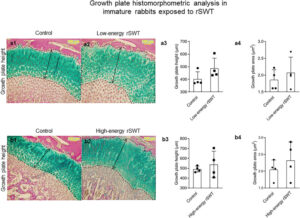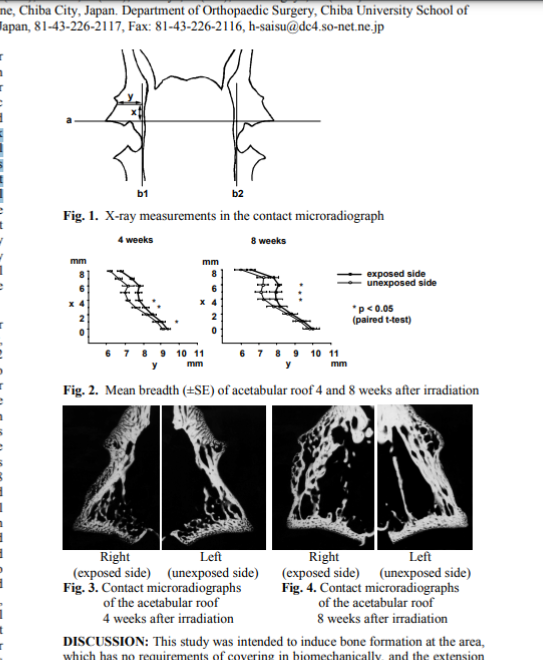It’s always exciting to see new possible treatments but this one may be pretty minor. Extracorporeal shockwave treatment has been written about on the blog before. Some more. These studies found that extracorporeal shockwave treatment can stimulate growth. Extracorporeal shockwave treatment can also stimulate the periosteum.
There are extracorporeal shockwave therapy machines for sale but they’re like $1,000.
Radial shockwave treatment promotes chondrogenesis in human growth plate and longitudinal bone growth in rabbits
“The process of longitudinal bone growth occurs at the growth plate where the chondrocytes undergo apparent structural and molecular changes to promote growth. Recent reports suggest that radial shockwave treatment (rSWT) stimulates bone length in cultured fetal rat metatarsals. Therefore, we investigated if rSWT has similar growth promoting effects on cultured human growth plate fragments and addressed the same in a preclinical in vivo rabbit model by subjecting their growth plates to rSWT.
Short-term effects of high-energy rSWT were evaluated in a unique model of cultured human growth plate cartilage (n = 5) wherein samples exposed to rSWT were assessed for chondrogenic markers at 24 h in comparison to unexposed samples obtained from the same limb.
Local in vivo effects were studied in six-week-old rabbits{6 week old rabbits are about equal to 42 week humans which is very young} who had their distal femurs exposed to four weekly sessions of rSWT at low- and high-energy levels (n = 4 each){weekly sessions are not that much}. At sacrifice, histomorphometric and immunohistochemistry analyses were performed. For effect on longitudinal growth, proximal tibiae of 22-week-old rabbits (n = 12) were asymmetrically exposed to rSWT; the contralateral side served as untreated controls. At sacrifice, the final bone length was measured.
In the ex vivo model of cultured human growth plate cartilage, rSWT exposure upregulated SOX9 and COL2A1 compared to control.
In the immature rabbit model, an increased number of proliferative chondrocytes and column density was seen for both the energy levels. In the adolescent rabbits, an increase in tibial length was observed after the fourth session of high-energy rSWT and until six-weeks after rSWT compared to the untreated limb.
Our preliminary experimental results suggest that rSWT may serve as a non-invasive treatment and possibly a safe strategy to stimulate longitudinal bone growth. However, further studies are needed to assess the in vivo effects of rSWT in models of disturbed bone growth.”
“22-week-old healthy rabbits (n = 12; 7 females, five males; weight 2.0–2.5 kg) was performed to document the effects of high-energy rSWT (3000 impulses, 180 mJ, 5 Hz) once weekly for four weeks on bone length. “
” Low-level laser beams and ultrasound are non-invasive modalities that have been investigated without success. Extracorporeal shockwave therapy (SWT) is a candidate for non-invasive modulation of growth plate activity as it has been successfully tested in fracture healing, nonunions, and other musculoskeletal disorders with minor complications in the clinic “
“After exposure to rSWT, gene expression analysis was performed after 24-h of culture. We observed increased expression of SOX9 (mean fold change: 3.0 ± 2.3) and COL2A1 (mean fold change: 19.0 ± 29.26) in treated samples when compared to untreated controls”
“he chondrocytes-column density (columns per mm growth plate width) in the proliferative zone was significantly increased in both the low-energy (low-energy rSWT: 40 ± 12 and control: 32 ± 9) and the high-energy rSWT groups (high-energy rSWT: 51 ± 13 and control: 37 ± 3)”
That looks like a pretty dramatic impact. Although shockwave also increased chondrocyte apoptosis so it’s possible that it increases growth rate but not total growth plate assisted height.
“At 26 weeks of age, after four sessions (at weekly intervals) of high-energy rSWT, there was a significant increase in the differences between the lateral tibial length measured on radiographs when compared to untreated controls (mean difference: 0.28 cm; p = 0.008). Six-weeks after the last session of high-energy rSWT the difference in the lateral tibial length treated bones compared to untreated controls was 0.03 cm (p = 0.001)” Rabbit tibial length may be about 10cm. So 0.28cm is like a 2.8% increase. Which is kind of significant.
” it is challenging to maintain this significant increase in bone length when dealing with healthy animals as the bone lengths tend to equalize after treatment withdrawal”<-so it may only affect growth rate not growth capacity.
So basically it’s worth studying but we don’t know if it only increases growth rate.

“Previous studies that used fSWT, a device used for its osteogenic effects, showed no effect on the growth plate cartilage in rats and rabbits”
“The high-energy rSWT used in the histological study did not cause cell death as measured with apoptotic markers and was considered safe for longitudinal bone growth experimentation.”
“one of the animals that received high-energy rSWT showed excess bone formation in the medial femoral condyle proximal to the growth plate in the metaphyseal region. This could be an adverse consequence of rSWT on periosteal cells proximal to the growth plate reflecting either increased vascularity or traumatic detachment of the periosteum. Therefore, careful evaluation needs to be considered when translating rSWT to patients as it may cause unpredictable excess growth akin to a metaphyseal fracture.”<-this is huge for us! We want excess bone formation!
Here is the excess bone formation in question:

“When investigating the effects of high-energy rSWT, we found up to 1% increase in the final bone length in treated adolescent rabbits when considering the observations as paired data. An earlier study in rabbits using (piezoelectric device) focal extracorporeal shockwave therapy (fSWT) supports the growth stimulatory effect . Our study is different from the previous one in three ways. First, we used rSWT, which is safer because it generates less energy with low penetration than piezoelectric fESWT. Second, we exposed adolescent animals to rSWT and followed them until growth plate fusion to know if the changes in bone growth were sustained until the end of growth. Thirdly, we performed molecular and histological studies to demonstrate effects at the growth plate level.”
“observed stimulation of growth following rSWT could be due to cellular changes within the growth plate. It is plausible that the stimulated resting chondrocytes may have augmented the propagation of daughter cells during their subsequent entry into the proliferative zone, thus contributing to an increased columnar density”
Here’s a study that shows that extracorporeal stimulation can add bone to the hip:
Acetabular augmentation induced by extracorporeal shock waves in rabbits
“We conducted this animal study to demonstrate whether exposing the acetabulum in immature rabbits to extracorporeal shock waves induces bone formation in the acetabulum. Five thousand shock waves of 100 MPa each were directed, from outside, at the acetabular roof of eight immature rabbits. At each of two time points (4 and 8 weeks) after treatment, the pelvises of four rabbits were removed and evaluated morphologically. Woven bone formation was observed on the lateral margin of the acetabular roof at 4 weeks after treatment, and the breadth of the acetabular roof in the coronal plane was significantly increased{coronal plane is basically length}. Eight weeks after treatment, the woven bone disappeared; the breadth of the acetabular roof, however, was significantly increased. These findings demonstrated that extracorporeal shock waves induced acetabular augmentation in rabbits. We conclude that extracorporeal shock waves, perhaps, could be applied clinically for the treatment of acetabular dysplasia.”
“No fracture was observed on the plain X- ray photo during the
monitoring period after irradiation.”
“Extracorporeal shock wave therapy, which was developed for lithotripsy, is thought to be also useful
to give dynamic loading to organs noninvasively. Shock wave demonstrates its physical action specific on bone as on calculus . It was reported that exposure to shock waves caused fracture of cancellous trabecula or periosteal lifting”
“Eight male New Zealand White rabbits aged 9 weeks weighing 1.0-1.2kg were used. Piezolith 2300 (Richard Wolf Inc., Germany) was used to produce extracorporeal shock waves. Ultrasonic waves were used for focusing. The focus was set in 3 mm cranial from superolateral edge of the acetabulum and 2 mm inside from lateral margin of the acetabular roof. Each 4 animals of the 8 animals were grouped into Group I and II. Shock waves were irradiated on the right acetabular roof from outside. The strength and the number of the shock wave were set to be 100 MPa and 5000 times respectively.”

Source link
